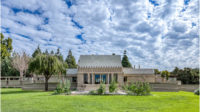A casual passerby might never guess that the Santa Barbara Museum of Art (SBMA) recently underwent a $50-million, 6-year expansion and renovation—which was exactly Bob Kupiec’s goal. Kupiec, principal of the eponymous local firm, and his team, along with Altieri Sebor Wieber engineers, completed the first two parts of a five-phase project this August, which was generously publicly funded.
The stately institution has been a staple of Santa Barbara’s historic downtown since 1941 and today still matches the locale’s quintessential Mediterranean architecture. However, before the renovation, many layers of the museum’s history remained unseen, making the undertaking much larger than initially planned.
A neoclassical post office from 1912, the structure was transformed in 1941 by architect David Adler into SBMA, and in 1942, a single-story McCormick gallery became the museum’s first addition. Originally built with reinforced bricks and two-and-a-half stories high, the majority of the museum was fully supported by the early 1900s structure, and merely resting on it. This folly, along with asbestos, lead paint, and seismic issues accrued through the years, were just part of a long list of the critical needs that the architects uncovered during the design phase and overhaul. (There were several other interventions in the 80s and 90s, but none remedied the design flaws.)
For the first phase of the 70,000 square-foot master plan (35,000-square-feet have been addressed), Kupiec introduced all-new mechanical, air handling, climate control systems, lighting, roofs, improved ventilation, and storage facilities. These improvements, along with a newly-constructed art receiving facility and additional galleries, brings the art institution into the 21st century. “The most serious decision an architect makes in designing a museum is what the threshold from one room to another looks like,” Kupiec jokes. In SBMA’s new portions, limestone hallways and common areas lead to galleries with oak floors. The warmth of the natural materials in the new Contemporary gallery keep it from feeling sterile.
The architects also addressed SBMA’s safety issues by demolishing and rebuilding the 1942 extension, which is now split into the McCormick Gallery on the first story and the new Contemporary Gallery on the second story, and fully reinforced with steel beams. “The new part of the building is the safest place,” says Kupiec. “I know where I want to be [in an emergency] .” The museum is now newly-stabilized with helical screws for earthquakes, as are the art storage racks below street level.
When walking between the updated sections and the existing galleries, lighting design is one of the most visible differences. In the McCormick Gallery, for example, recessed LED lighting, cast in fiberglass, is diffused using rounded edges and mimics daylight. The architects also installed lighting occupancy sensors throughout the building for energy conservation. Kupiec says museums are one of the most difficult building types for adhering to California’s stringent Title 24 building code—which calls for energy efficiency in mechanical and electrical systems—due to dehumidification issues and air tempering, among other museum-specific challenges.
From the main entrance, visitors flow into Ludington Court, a renovated, salon-style hang with double-height ceilings and rounded archways dating back to the structure’s original 1912 design. A marble statue from Hadrian’s Villa presides in the middle of the room and is lit by existing skylights, which were reduced in size to allow for more mechanicals on the roof. In fact, all of the mechanical systems were fitted as tightly as possible so as not to give up floor space. SBMA director and CEO Larry Feinberg credits this new intervention to allowing the museum to show more of its 25,000-object permanent collection.
The SBMA fully reopened to the public on August 15, corresponding with the institution’s 80th anniversary, and after being mostly closed since November 2015 (approximately one-third of the galleries remained open). The next phases of the master plan, according to Kupiec, is dependent on public funding, so the timeline has not been established.






-Hamon-Forecourt-View--Nieto-Sobejano-Arquitectos.jpg?height=200&t=1691218537&width=200)



